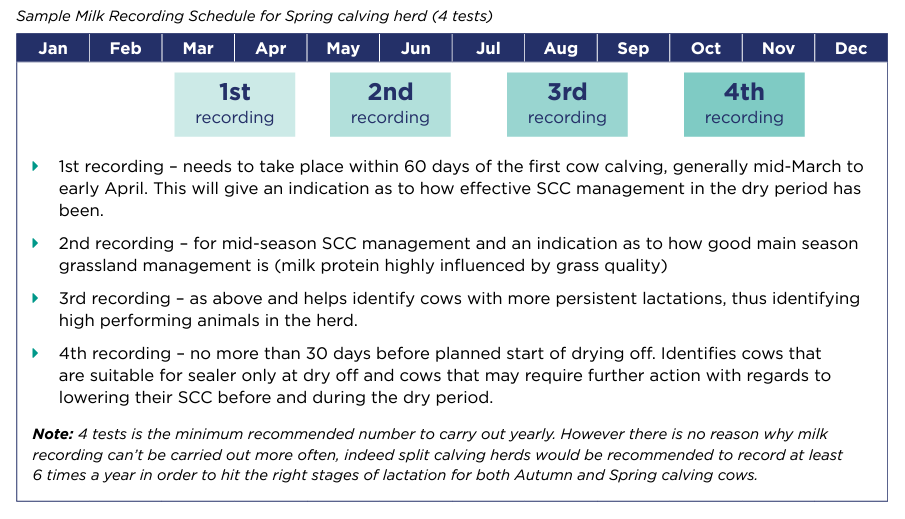milk recording
Increasing the uptake and frequency of milk recording is an agreed key target for the Irish dairy industry to help ensure milk quality and reduce herd SCCs.
At a farm level, milk recording has multiple benefits. It is key in preventing the spread of contagious mastitis, detecting new infections quickly, identifying the most efficient cows for breeding and when milk recording is completed within the first 60 days of calving, it can be used to evaluate the dry period.
Despite the benefits associated with milk recording, many are still choosing not to do so. It is sometimes regarded as being expensive (about €15 per cow per year) and can disrupt the milking routine when time and labour may be in short supply. So, what are the real benefits of milk recording?
Research carried out by Teagasc in conjunction with Animal Health Ireland highlights the economic benefits of milk recording using yearly information from the Teagasc National Farm Survey, from a representative sample of 516 dairy farmers spanning from 2008 to 2019. The analysis shows that the economic benefits of milk recording outweigh the costs, notably by helping farmers to breed and manage healthier and more productive cows. On average, when farm performance was compared for those farmers who milk record (about 45% of the sample) and those who do not (55%):
- Gross margin per cow was €39 larger
- Milk yield per cow was 178 L higher
- Milk solids per cow were 29 kg higher
- Herd somatic cell count (SCC) per mL of milk was 13,000 cells lower.
The comparison between herds that milk record and non-milk recording herds was performed having accounted for the effect of other farm and farmer characteristics. These include herd size, stocking rate, dairy specialisation, the completion of formal agricultural education, discussion group participation, reliance on hired labour, farmer household size and age, regional location, weather, and price volatility.
As we move towards selective dry cow therapy (SDCT), implementing milk recording is becoming increasingly important for routine mastitis monitoring, as well as to identify cows that require antibiotic treatment at drying off. Your prescribing veterinary practitioner needs to use cow- and herd-level infection to guide their decision-making, so that antibiotics at drying-off are only administered to those animals with diagnostic evidence of infection. It is important to commence whole herd milk recording as soon as possible as it is the best way to gather this cow and herd level information.
Milk Recording Options
Herdowners have two different milk recording options:
- Electronic DIY (EDIY) Milk Recording
- Manual Milk Recording
When to record?
With the CellCheck Farm Summary Report, milk recording cows within 60 days of calving will measure the effectiveness of your dry cow treatment. This is critical for any farmer who was battling high SCC in the previous year and who undertook a programme of targeted dry cow therapy. It will also highlight if new infections during the dry period have occurred.
For spring calving herds this would mean that milk recording should be carried out in the mid-March to early April period. Leaving it later than this means your earlier calved cows will be further than 60 days into lactation. Early lactation mastitis is a high risk. Early milk recording will give you an indication of any cows that need prompt attention.
Below is a recommended milk recording calendar for a spring calving herd:

Getting Started with Milk Recording? see our tips to getting started:
- Identification – Freeze branding cows is the fool-proof method of identification. Make sure freeze brands are visible on the day of recording. Electronic tagging of all female dairy calves should also be considered.
- In parlours with Auto-ID, make sure tags or pedometers are reading correctly and registered correctly on the computerised system.
- Contact your local milk recording organisation prior to first recording to ascertain what equipment is needed.
- Make sure all equipment is clean before sampling (i.e., jars, jar taps & sampling bottles).
- Good records – recording calving dates & dry-off dates is extremely important to have accurate milk recording data. Your herd also needs to be on the ICBF database, all reports are uploaded to this and available for viewing on your ICBF page.
- If going down the eDIY route, have help available for the days you are recording. Milking will take longer on these days so be prepared for it. It is also possible to have a recorder accompany the eDIY meters and do this work for you, this is something worth considering.
Lifetime Milk Recording Reports
get in touch
If you need help or advice, please contact a member of the milk quality advisory team
